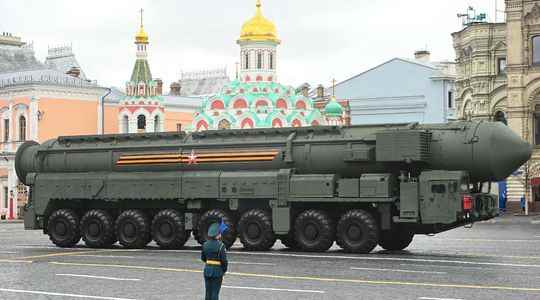Russia is using in its offensive against Ukraine part of its new generation of missiles, described as “invincible”, “hypersonic”, with unlimited range or invisible to radar, four years after being unveiled by Vladimir Putin. Overview.
- Avangard, “invincible” missile
Russia’s hypersonic Avangard (“vanguard” in Russian) missiles are capable of changing course and altitude at very high speeds, making them “virtually invincible” according to Vladimir Putin, who compares the scientific and military breakthrough of their development” to the creation of the first artificial satellite of the Earth”, the famous Sputnik.
Successfully tested in December 2018, their speed then reached Mach 27 – 27 times the speed of sound – and hit a target around 6,000 km away, according to the Russian Ministry of Defense. They were put into service in December 2019.
- Kinjal, hypersonic “dagger”
Used for the first time Friday by the Russian army, the hypersonic missiles Kinjal (“dagger” in Russian) allowed according to Moscow the destruction of an underground warehouse of armaments in the west of Ukraine. This type of missile, very maneuverable, is supposed to challenge anti-aircraft defense systems. During the tests, they hit all their targets at a distance of up to 1000-2000 km. They equip the MiG-31 war planes. Their use in Ukraine is a world first for hypersonic weaponry, experts say.
- Sarmat, from the North Pole to the South Pole
The fifth-generation Sarmat heavy intercontinental ballistic missile is also supposed to evade missile defenses. Weighing over 200 tons, it is more capable than its predecessor – the Voevoda missile with a range of 11,000 km – and “has practically no limits in terms of range”, according to Mr Putin, who l judged able to “aim at targets crossing the North Pole as well as the South Pole”.
- Peresvet, combat laser
The technical characteristics of Peresvet combat laser systems (named after a 14th century warrior monk) are secret. They have been combat-ready since December 2019, according to the Ministry of Defense.
- Poseidon, underwater drone
The Poseidon, an underwater drone developed for the Russian nuclear deterrent, will be able to move more than a kilometer deep, at a speed of 60 to 70 knots, while remaining invisible to detection systems, according to a source within the Russian military-industrial complex, quoted by the official agency TASS.
Tests of the Poseidon system took place in the spring of 2020 to eventually equip the nuclear submarine Belgorod, a ship which was launched in 2019 but whose commissioning has been postponed, according to the Tass agency. least until the summer of 2022.
- Bourevestnik, the storm bird
Again with an “unlimited range”, still according to Vladimir Putin, and capable of overcoming almost all interception systems, the Burevestnik cruise missiles (a sea bird whose Russian etymology is the word “storm”) nuclear propulsion are being developed by the Russian military. Their technical characteristics are secret.
- Zircon, “invisible” marine missile
The first official launch of the Zircon hypersonic missile (named after a mineral used in jewelry) dates from October 2020. It flies at Mach 9 to reach maritime and land targets.
At the end of December 2021, Vladimir Putin announced a first successful test firing of a Zircon salvo. Other tests have taken place since October 2020 in the Russian Arctic, in particular from the Admiral Gorchkov frigate and a submerged submarine.
